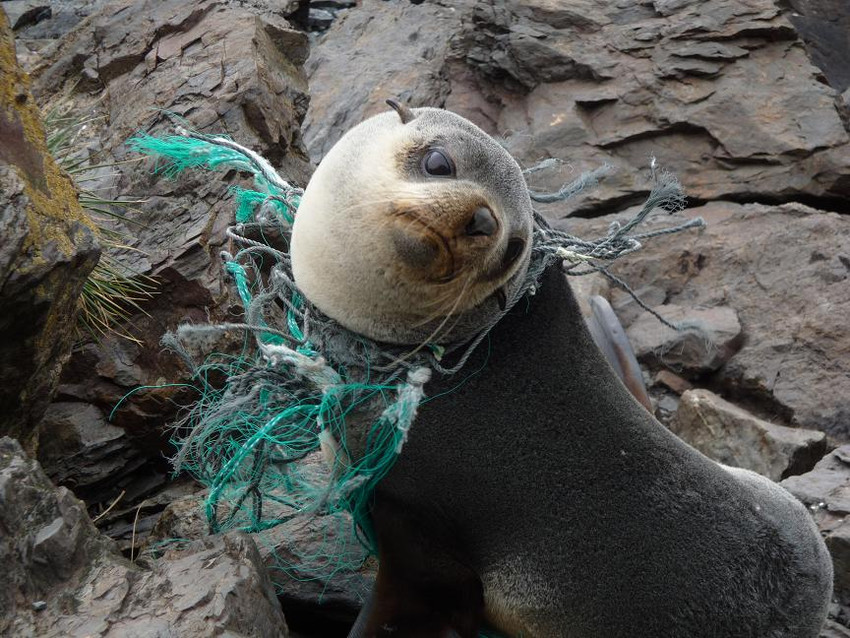A seal trapped in plastic debris
Photo Ewan Edwards/The Clipperton project
From HuffingtonPost by Andreas Merkl (Ocean Conservancy)
Today, Ocean Conservancy released a major report: Stemming the Tide-Land-based strategies for a plastic-free ocean.
We think it's a big deal.
It squarely addresses one of our biggest worries: the avalanche of plastic that cascades into the ocean every year.
It's getting really bad.
Practically every kind of animal, from plankton to whales, is now contaminated by plastic.
It's in the birds, in the turtles, in the fish.
At the current rate, we could have 1 ton of plastics for every 3 tons of fish by 2015.
This is nobody's plan.
It's not the plan of the plastics industry, it's not the plan of the consumer goods industry and it's certainly not the plan for those of us who love and need the ocean.
Nobody wants this.
The problem is born on land.
Most of the plastic originates in rapidly industrializing countries whose waste management infrastructure is lagging behind.
This is a typical phase of development that all countries go through.
The problem is simply that the enormous utility of plastic, combined with the explosive economic growth of Asia and Africa, combine to yield an enormous flow of unmanaged plastic waste into the ocean.
The majority of plastic waste ending up in dumps and in waterways is composed of thin films used in grocery bags and food packaging.
This type of material is very low value after it is discarded and there is little economic incentive to pick it up.
Blown or washed into the ocean, it breaks apart, and becomes the "microplastic" that is so easily mistaken by animals for tasty zooplankton.
These microplastics are ubiquitous, found everywhere from the equator to the poles, and it is a real and rapidly growing problem.
By comparison, the famous ocean gyres, or "garbage patches", which are considered to be the most concentrated areas of plastic in the ocean, contain only a small percentage (< 3 percent) of all plastics entering the ocean.
So what to do?
We are fortunate, in a sense, that the plastic flow into the ocean is quite concentrated.
Only five Asian countries account for the majority of the flow.
Within these countries, there are a limited number of cities, rivers and watershed that really matter.
We know where we need to go.
A "fish market" in Hong Kong. Most plastic pollution in the ocean originates from five Asian nations.
In developing regions, the most troublesome plastic waste tends to be in the form of low-value bags and thin films.
photo : Fedor Selivanov
In these places, we need to first concentrate on the basics: the safe collection, transportation and storage of plastic waste.
By optimizing the waste hauling system, increasing collection rates to 80 percent and advancing waste treatment and conversion technologies in these five countries alone, we could cut the flow of plastic into the ocean by 45% by 2025.
Stemming the Tide lays out in detail how the various elements of the solution have to come together, what they cost and who needs to be involved.
This is clearly a solvable problem, but it will require the cooperation of many groups: industry, cities, national governments, multi-lateral organizations, banks, NGOs.
Together, we need to create the conditions that make it possible for investors and entrepreneurs to invest in integrated waste management solutions.
This is a classic example of a global problem with local solutions.
The good news is that the global community is becoming very concerned about the ocean plastic problem.
We can concentrate global expertise and resources on local problems, greatly accelerating the rate at which the fundamental waste management infrastructure is built.
Ocean Conservancy created the Trash Free Seas Alliance® (Alliance) specifically to focus these global resources on the right local problems.
It consists of NGOs, corporations and scientists that have come together to create pragmatic, real-world solutions focused on the measurable reduction of ocean plastics.
Stemming the Tide is a signature initiative of the Alliance with support from the American Chemistry Council, The Coca-Cola Company, the Dow Chemical Company, REDISA and WWF, and was advised by a broad set of experts from the industrial, finance and waste management realms.
For the Alliance, this report is only the end of the beginning: it is the start of a global effort to turbo-charge the development of ocean-smart waste management infrastructure in the places that really matter.
Links :
- The Guardian : By 2025, our seas may be filled with one ton of plastic for every three tons of fish
- Wired : Adding more plastic to our oceans could clean them up
- BBC : Plastic oceans: What do we know?

No comments:
Post a Comment